Transferencias monetarias multipropósito
Las TMM son transferencias de efectivo sin restricción que las personas afectadas por una crisis pueden utilizar para cubrir sus necesidades básicas. Por su naturaleza, las TMM son la modalidad de asistencia que ofrece a las personas un máximo grado de elección, flexibilidad y dignidad. También existen cada vez más evidencias de que son más costo-eficientes y costo-efectivas para satisfacer múltiples necesidades.
No obstante, las TMM requieren nuevas formas de colaboración entre los actores humanitarios, en todas las etapas del ciclo del programa, así como entre sectores. Si bien existen herramientas sólidas para fomentar la colaboración, éstas no han sido ampliamente adoptadas y las TMM todavía son utilizadas de manera ad hoc. Quedan desafíos por abordar si queremos integrar las TMM en el sistema humanitario con éxito.
Iniciativas relacionadas
Contenido destacado
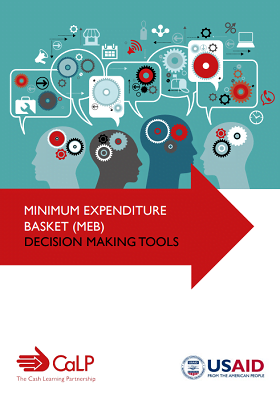
Minimum Expenditure Basket (MEB) Decision Making Tools
Guidelines and Tools
Update: This publication was revised in 2022. Please read the revised publication here.
The purpose of this tipsheet is to accompany practitioners and decision makers through key stages in the process of calculating an MEB to: (a)
identify what is the most appropriate path to take in relation to their
particular context, identified objective, existing capacities and available
resources; and...
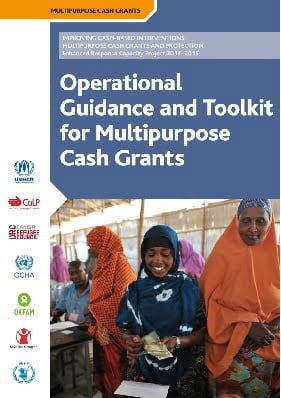
Operational Guidance and Toolkit for Multipurpose Cash Grants
Guidelines and Tools
This operational guidance and toolkit brings together worldwide expertise on cash-based interventions (CBIs). It provides comprehensive and practical guidance for humanitarian actors to assess the feasibility, conceptualise the design and structure the implementation of MPGs. The guidance focuses on MPGs whose primary objective is to meet basic needs as defined by affected people...

Definition of Minimum Expenditure Baskets (MEB) in West Africa
Report
Throughout 2017, five countries in West Africa have worked collectively to define minimum expenditure baskets, in order to better capture the contribution that humanitarian assistance is making to address the basic needs of affected populations, and improve the impact of assistance. This heavy process raises technical and coordination challenges. The CALP Network, with support from USAID /...
Últimos recursos

A Learning Review of Multi-Purpose Cash Assistance in Afghanistan
Report
In 2022, Islamic Relief Worldwide implemented a multi-million emergency humanitarian project in Afghanistan supported by the United Nations Development Programme (UNDP) funded Area-based Approach for Development Emergency Initiative (ABADEI) programme.
The 13-month-long project had three main...

Integrating Livelihoods Support into Emergency Assistance Programming
Guidelines and Tools
This report draws on research and learning to advocate for broader consideration of expanded humanitarian response programming, especially in situations of prolonged crises. Livelihoods programs have a crucial role to play in emergency settings, especially when combined with and aligned with cash...

Colombia and Lebanon Evaluation Report: Measuring the impact of cash on child protection outcomes
Report
As humanitarian crises break down traditional protection mechanisms and the loss of income restricts access to basic resources, children become increasingly vulnerable to abuse, neglect, exploitation, and violence. Cash and Voucher Assistance (CVA) is a critical modality that is increasingly being adopted...

Cash & Voucher Assistance (CVA) & Child Protection (CP) Global Study – Research Report in the DRC, Egypt, Lithuania and the Philippines
Report
Since 2022, Save the Children has been scaling up its use of CVA for Child Protection (CP) programming through various pilot projects.
Research was commissioned in four countries in 2022-23 to generate evidence and learning to inform the design of future programming but also to design a robust...
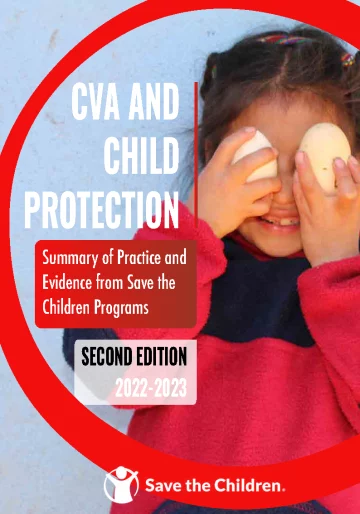
Cash and Vouchers Assistance (CVA) and Child Protection: Summary of practice and evidence from Save the Children programmes 2023 Edition
Report
In an effort to increase global knowledge and learning, Save the Children conducted a global review of twenty Country Offices and their programs in order to assess and highlight the impact that different forms of Cash and Vouchers Assistance (CVA) have on Child Protection (CP) outcomes, to identify...

UNFPA Estudio de caso: la mitigación del riesgo de VBG en la asistencia en efectivo en Iraq y Colombia
Case Study
En 2022-2023, el Fondo de Población de las Naciones Unidas (UNFPA) y el Instituto Mundial de la Mujer de la Universidad George Waimage-20240305162548-1shington llevaron a cabo una investigación operacional en Iraq y Colombia con el objetivo de desarrollar indicadores indirectos para mitigar el riesgo...
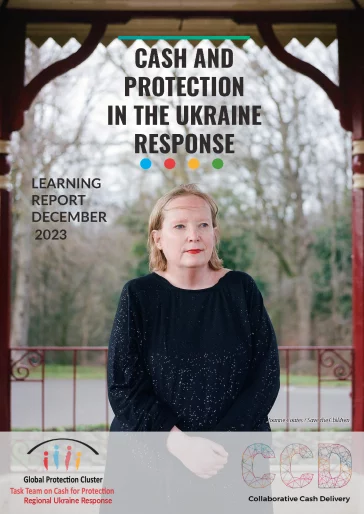
Cash and Protection in the Ukraine Response
Report
This learning report stems from bilateral discussions with the Collaborative Cash Delivery (CCD) Network’s members in Ukraine and Poland, many of whom were on the cusp of designing or implementing C4P programmes as part of the Ukraine response and were seeking learning and experience from each other.
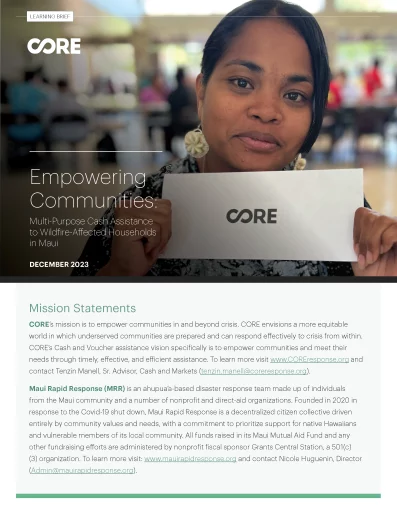
Empowering Communities: Multi-purpose cash assistance to wildfire-affected households in Maui
Case Study
On August 8, 2023, catastrophic wildfires in Maui County, Hawaii spread rapidly due to intense winds brought on by Hurricane Dora, devastating the town of Lahaina and causing widespread displacement across communities. It ranks as one of the 10 deadliest wildfires in US history since 1871 and the largest...

Understanding how Cash and Voucher Assistance Programs for Nutrition are Implemented: A review of programmatic case examples from Burkina Faso, Mali, Niger, Somalia, and Colombia
Report
The purpose of this review was to identify and document case examples of programs in different countries and contexts that use cash, vouchers, or in-kind food assistance with nutrition activities to understand why and how these programs are implemented, and identify innovations that may inform and support...

Will our Opinion Matter? Community consultations on the design of multi-purpose cash programmes in Lebanon
Report
Since late 2019, Lebanon has been grappling with a severe economic and financial crisis. The Lebanese lira has lost more than 98 percent of its value, and over half of the Lebanese population is estimated to be living in poverty. The Government of Lebanon and development and humanitarian agencies have...
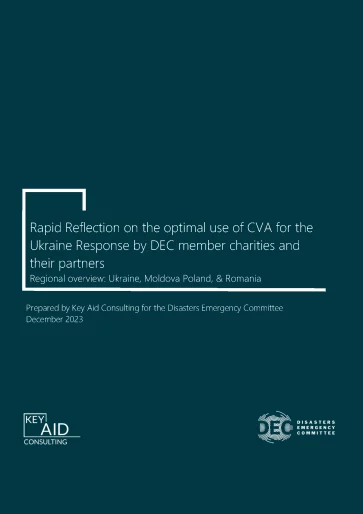
Rapid Reflection on the Optimal Use of CVA for the Ukraine Response by DEC Member Charities and their Partners
Report
Since February 2022, Ukraine and the neighbouring countries are facing a humanitarian crisis of unparalleled scale, ranking among the fastest-growing crises observed in the past decade and the largest in Europe since the end of World War II. In the first two months of conflict, more than 30 percent of...
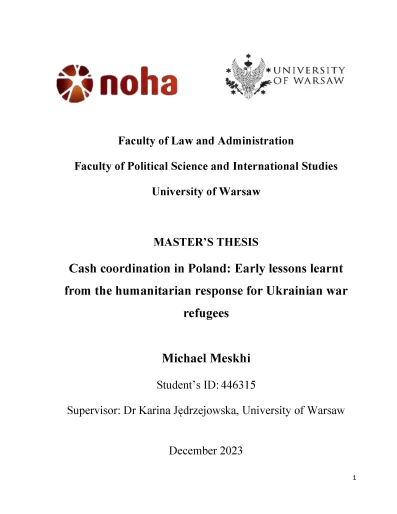
Cash Coordination in Poland: Early lessons learnt from the humanitarian response for Ukrainian war refugees
Case Study
This thesis was submitted for obtaining the Master’s Degree in International Humanitarian Action. By submitting the thesis, the author certifies that the text is from his hand, does not include the work of someone else unless clearly indicated, and that the thesis has been produced in accordance with...
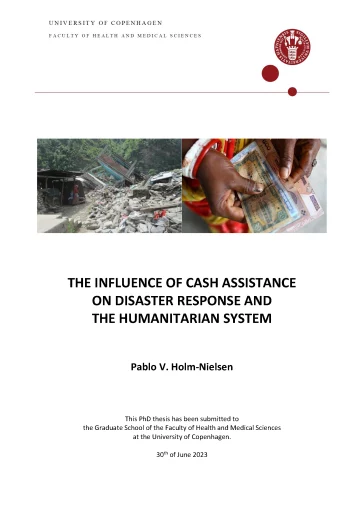
The Influence of Cash Assistance on Disaster Response and the Humanitarian System
Report
The research presented in this thesis is based on four studies that cover various aspects of the
transformative effect of CVA on humanitarian organizations and the humanitarian system. Study 1 shows the changes that the humanitarian organizations have experienced due to the shift to CVA. New skillsets...

Joint Market Assessment Round 2
Report
This report assesses the feasibility of implementing Cash and Voucher Assistance (CVA), specifically Multipurpose Cash Assistance (MPCA), to support individuals impacted by the February 6 earthquakes. The evaluation focuses on the acceptance of various forms of cash modalities, availability of key items,...

Cash and Voucher Assistance at Scale: Addressing food insecurity by supporting families in the Netherlands
Case Study
With an increasing number of families experiencing financial trouble in the Netherlands, in September 2022, the Dutch parliament voted to allocate €100 million for free school meals in vulnerable neighbourhoods across the country. After the proposal was approved, the Dutch Ministry of Education, Culture...

Piloting Mobile Money Cash Assistance in Sudan
Case Study
In the 7 months since the onset of conflict in Sudan in April 2023, an estimated 6.1 million people have been displaced, making Sudan the country with the highest number of displaced individuals globally. Humanitarian organizations are considering cash assistance as a response to the crisis, employing...

Feasibility study on CVA in Tigray Region, Ethiopia_October 2023
Report
The two years of conflict in Tigray has fueled a large-scale humanitarian crisis and resulted in loss of livelihoods and widespread food insecurity of the population especially Internally Displaced Populations and agrarian communities in the region.
The crisis affected the livelihoods of the...

WVI Cash Roadmap 2.0 – New Avenues – Leveraging, multiplying “Nexus” cash to take children and their families further than imagined
Policy paper
WVI's strategic global Cash Roadmap 2.0 (2024-2027) speaks to the organisations' commitment that amidst polycrises and resourcing constraints, there is urgency to maximise and multiply World Vision's capabilities, assets and cash voucher programming (CVP=CVA) is a powerful tool to do so.
Increasing...

Recommendations on Cash for Protection for General Protection Actors
Report
The aim of this document is to offer recommendations on the use of Cash for Protection interventions in Ukraine, including to create a common understanding among humanitarian partners, and to harmonize practices. This includes: ● Defining Cash for Protection & its objectives ● Scenarios for possible...
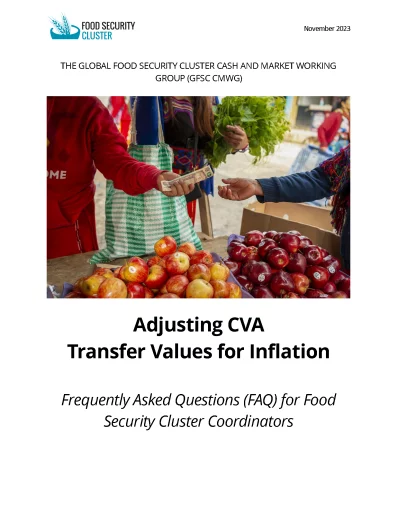
Adjusting CVA Transfer Values for Inflation: Frequently Asked Questions (FAQs) for Food Security Cluster Coordinators
Guidelines and Tools
Over the past 3 years, the global community has experienced a series of unanticipated, challenging, and interrelated shocks: COVID-19, conflict, climate change, and rising costs. A significant number of countries experienced substantial levels of local currency depreciation coupled with high inflation,...


